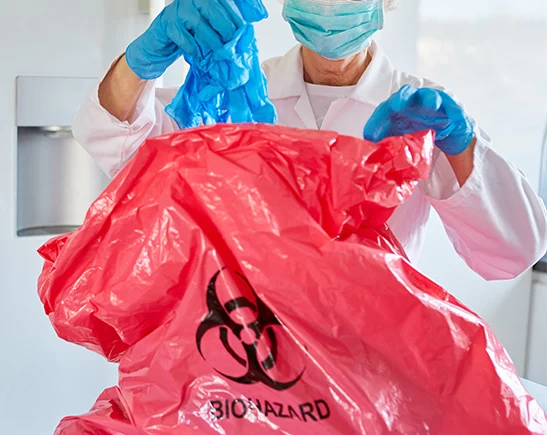Know-how Unleashed: Grasping the Art of Medical Waste Removal for Wellness Facilities
Know-how Unleashed: Grasping the Art of Medical Waste Removal for Wellness Facilities
Blog Article
Recognizing the Various Sorts Of Waste Disposal Strategies
In the world of waste management, the range of disposal techniques available today is huge and differed, each method serving an unique purpose in dealing with the obstacle of waste disposal. click here. From reusing techniques that aim to provide new life to materials, to the detailed procedures of harmful waste administration, the landscape of garbage disposal is complicated yet essential for ecological sustainability. Understanding the nuances of these different strategies not just drops light on the value of liable waste management but likewise prompts us to reconsider our approach towards waste disposal in a swiftly advancing world

Recycling Methods
Recycling techniques are crucial for sustainable waste administration techniques in both property and industrial setups. medical waste removal. By carrying out effective recycling strategies, a substantial amount of waste can be drawn away from garbage dumps, conserving natural deposits and reducing the ecological influence of production procedures
In domestic areas, curbside recycling programs play an important duty in encouraging houses to different recyclable products from general waste. Products such as paper, plastics, glass, and metals can be arranged and accumulated for processing into new products, minimizing the demand for raw products and energy-intensive production procedures.
Industrial centers likewise rely upon recycling techniques to decrease waste generation and advertise a circular economic climate. By implementing closed-loop systems, companies can reuse products within their production procedures, decreasing costs and environmental footprint. medical waste removal service. Furthermore, commercial recycling programs frequently entail partnerships with specialized reusing centers to guarantee that materials are appropriately sorted, refined, and reintegrated into the supply chain
Composting Strategies

Aerated fixed stack composting involves blending natural waste materials in a big heap and routinely turning it to make sure appropriate oygenation. This technique is fit for smaller-scale operations and homes.
In-vessel composting involves putting natural waste in a shut container with controlled problems for temperature level and oygenation. Windrow composting includes developing long rows of natural waste and on a regular basis transforming them to advertise disintegration - medical waste removal.
Land Fill Disposal
Landfill disposal is a commonly utilized technique for managing waste that can not be reused or composted. It includes burying waste in marked locations of land, with proper precautions to stop ecological contamination. Garbage dumps are engineered facilities made to separate waste from the surrounding atmosphere. The waste is compressed and covered with dirt daily to decrease odors, prevent parasites, and lessen the spread of litter. Modern garbage dumps are equipped with safety liners and keeping an eye on systems to stop leakage of damaging substances right into the soil and groundwater. Methane gas, a byproduct of breaking down organic waste in garbage dumps, is often collected and utilized as a source of renewable resource. In spite of improvements in garbage dump modern technology, issues continue to be concerning the lasting ecological influences, such as groundwater contamination and greenhouse gas exhausts. Efforts to reduce dependence on landfills include promoting waste reduction, reusing, and discovering alternate garbage disposal methods to lessen the ecological impact related to standard landfill disposal practices.

Waste-to-Energy Incineration
Incineration of waste for energy generation is a method progressively being thought about as a choice to standard landfill disposal methods. Waste-to-energy incineration includes the combustion of waste products at high temperatures, generally in specialized centers created to create electricity or heat through the procedure - click here. This strategy not just reduces the volume of waste that would otherwise be destined for land fills yet also uses the heat produced during incineration to develop power
Among the key benefits of waste-to-energy incineration is its capacity to create electrical energy while decreasing the environmental influence compared to traditional garbage dump disposal techniques. By transforming waste right into energy, this approach assists in decreasing greenhouse gas emissions and reliance on nonrenewable fuel sources for power generation. Additionally, waste-to-energy centers are furnished with advanced air pollution control modern technologies to minimize possible ecological contaminants released during the combustion procedure.
Hazardous Waste Administration

Taking into consideration the crucial importance of accountable waste monitoring methods, particularly in the world of ecological sustainability, the emphasis now moves towards the complex domain of Contaminated materials Management. Harmful waste positions significant threats to both human wellness and the setting, demanding specific handling and disposal techniques. Typical examples of harmful waste consist of chemicals, batteries, pesticides, and digital waste.
Contaminated materials Administration entails the recognition, collection, transport, therapy, and disposal of products considered possibly dangerous or harmful. This process requires adherence to strict laws and standards to alleviate unfavorable influences on environments and public health. Numerous techniques are used in managing contaminated materials, including recycling, safe and secure garbage dumps, encapsulation, and chemical treatment.
Proper Harmful Waste Monitoring is crucial for avoiding contamination of dirt, water resources, and air contamination. It is important for sectors, laboratories, healthcare centers, and various other generators of contaminated materials to execute robust management methods, training programs, and emergency situation response plans to guarantee the risk-free handling and disposal of these products. Failure to handle contaminated materials properly can have far-ranging consequences, highlighting the significance of attentive and responsible practices in this field.
Conclusion
To conclude, garbage disposal methods play a critical duty in handling and minimizing the effect of waste on the atmosphere. From reusing and composting to landfill disposal and waste-to-energy incineration, each method has its own advantages and limitations. Correct monitoring of hazardous waste is also necessary to shield public wellness and the setting. It is very important for industries and individuals to comprehend the various waste disposal techniques offered and pick one of the most appropriate technique for sustainable waste management.
In the world of waste monitoring, the range of see disposal techniques offered today is substantial and differed, each approach offering an unique function in resolving the obstacle of waste disposal. click here. From recycling methods that intend to give brand-new life to materials, to the complex processes of harmful waste monitoring, the landscape of waste disposal is complicated yet crucial for ecological sustainability. Recognizing the nuances of these different methods not only loses light on the importance of responsible waste administration however additionally motivates us to reassess our strategy towards waste disposal in a rapidly progressing globe
Initiatives to lower dependence on landfills include advertising waste reduction, reusing, and exploring different waste disposal methods to lessen the ecological footprint associated with standard land fill disposal methods.
It is important for markets and people to recognize the different waste disposal techniques available and choose the most appropriate approach for lasting waste management.
Report this page